Teagasc entomologist Dr. Louise McNamara has confirmed that grain aphids can cause Barley Yellow Dwarf Virus (BYDV)-related damage to a cereal crop within hours of arriving in it.
While it the length of time does depend on the type of aphid that alights within a crop, McNamara said “where the spread of BYDV is concerned, the spread of the disease is extremely fast indeed”.
“Aphids spend most of their lives feeding. So, it takes only a number of hours for the virus to spread from them into the crop,” she said.
Grain aphids
Aphids have lots of natural enemies; some are general, such as beetles and spiders, but some are specific.
“Natural enemies of aphids that are active right now include beetles and spiders. They can act to keep aphid numbers lower,” McNamara continued.
“But the challenge of growers is that they have no thresholds to work from: We do not know what exact numbers of aphids in a crop constitute a disease risk.
“It’s not that we can count and gauge if the aphids’ natural enemies have succeeded in keeping BYDV at bay.”
According to the entomologist, the likes of beetles and spiders will only act to keep a certain number of aphids at bay.
Moreover, their predator-related activity rate will be proportional to the number of aphids that are in their locality.
In addition, they will be attracted into a field on the back of the aphids being there in the first place.
“Min-till cereals have a lower risk of aphid infestation levels than is the case for crops established using more traditional techniques,” said McNamara.
“But this doesn’t always translate significantly, in terms of final yields. The effect is made stronger if straw is incorporated with the min-till.
“We are talking here about general patterns. There is no quantitative linkage between the quantities of straw and stubble in a field and the consequent reduction of a BYDV threat.
“If there is less of a contrast between the crop and the soil, it is harder for the aphid to land.
“But this doesn’t always translate significantly to yield,” the entomologist added.
“The flip side to this is that min-till establishment practises may result in higher volunteer numbers. Freshly germinating weeds will also constitute a green bridge.
“Both of these scenarios will prove attractive to aphids.”
